Economics Assignment: Australian Dollar (AUD) Exchange Rate Analysis
VerifiedAdded on 2021/04/21
|13
|2741
|39
Report
AI Summary
This economics assignment analyzes the Australian Dollar (AUD) exchange rate, focusing on its determination within the foreign exchange market using a demand-supply framework. The report explores the distinction between nominal and real exchange rates, presenting data on the fluctuations of the AUD and its trade-weighted index (TWI) over recent years, highlighting key influencing factors such as commodity prices, inflation, and government policies. It examines the impact of exchange rate fluctuations on imports, exports, and the balance of payments, with a particular focus on the relationship between the AUD and the USD. The assignment concludes by providing recommendations for the Australian government and the Reserve Bank of Australia to manage and influence the exchange rate, including export promotion, interest rate adjustments, and fiscal policies to address economic challenges such as stagflation.

Running head: ECONOMICS ASSIGNMENT
Economics Assignment
Name of the Student:
Name of the University:
Author’s Note:
Economics Assignment
Name of the Student:
Name of the University:
Author’s Note:
Paraphrase This Document
Need a fresh take? Get an instant paraphrase of this document with our AI Paraphraser
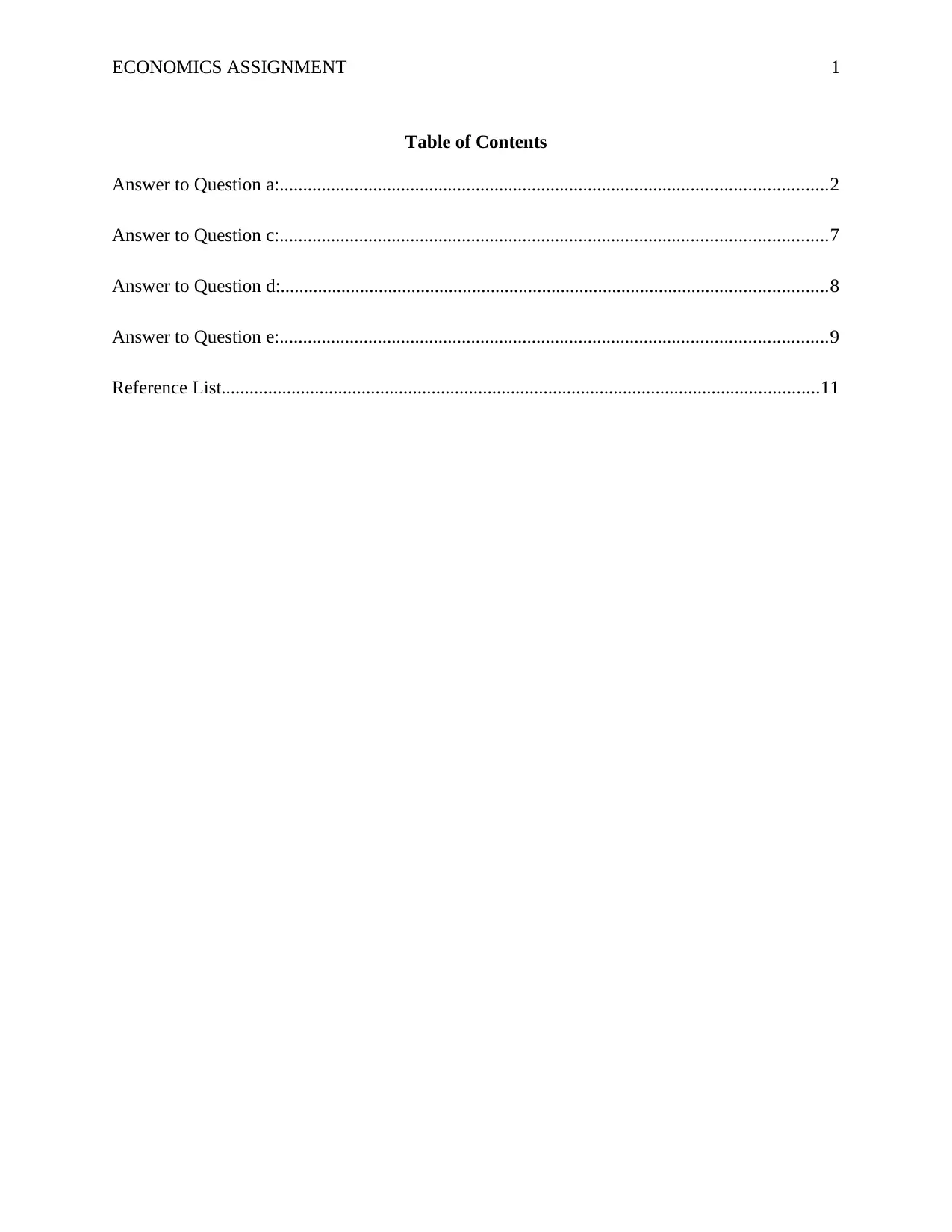
ECONOMICS ASSIGNMENT 1
Table of Contents
Answer to Question a:.....................................................................................................................2
Answer to Question c:.....................................................................................................................7
Answer to Question d:.....................................................................................................................8
Answer to Question e:.....................................................................................................................9
Reference List................................................................................................................................11
Table of Contents
Answer to Question a:.....................................................................................................................2
Answer to Question c:.....................................................................................................................7
Answer to Question d:.....................................................................................................................8
Answer to Question e:.....................................................................................................................9
Reference List................................................................................................................................11
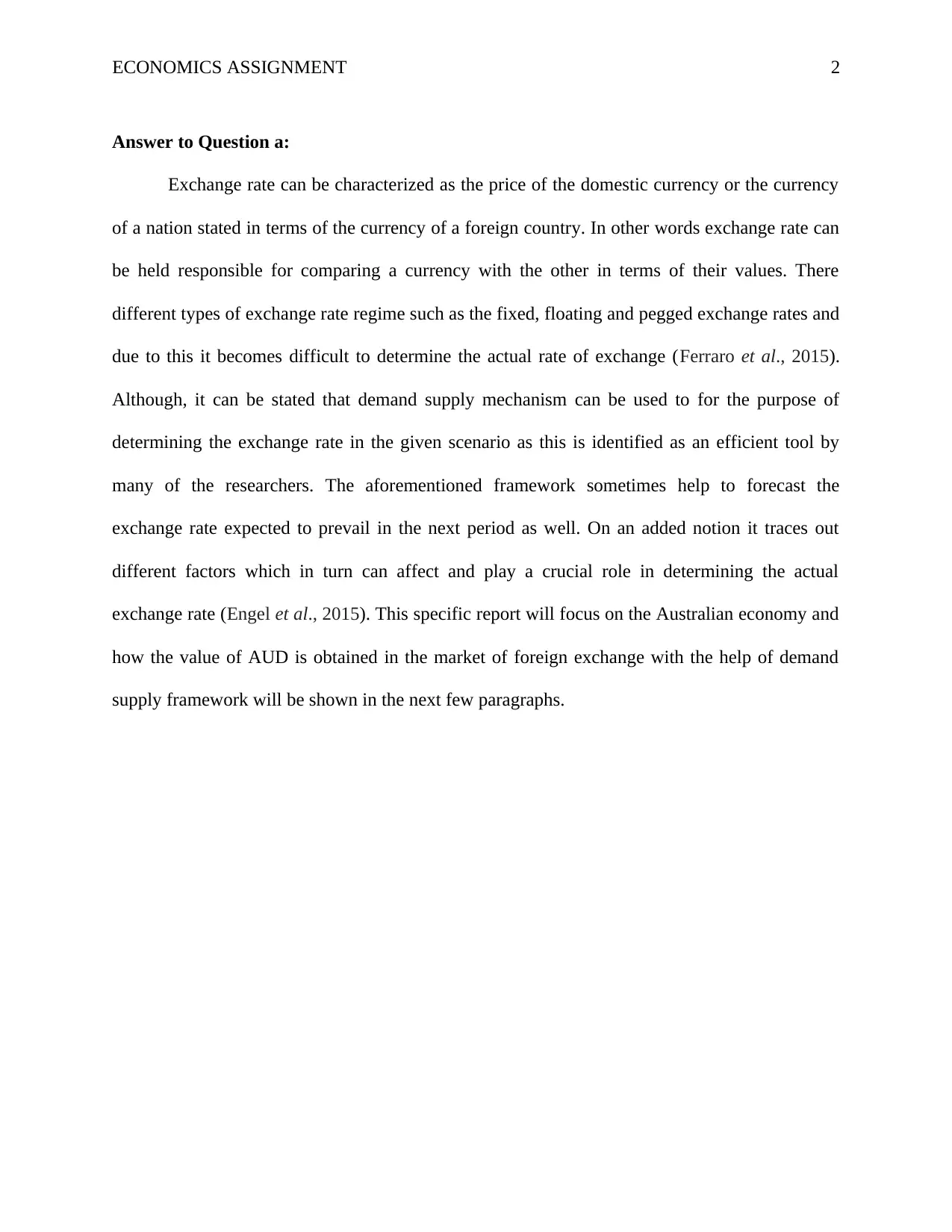
ECONOMICS ASSIGNMENT 2
Answer to Question a:
Exchange rate can be characterized as the price of the domestic currency or the currency
of a nation stated in terms of the currency of a foreign country. In other words exchange rate can
be held responsible for comparing a currency with the other in terms of their values. There
different types of exchange rate regime such as the fixed, floating and pegged exchange rates and
due to this it becomes difficult to determine the actual rate of exchange (Ferraro et al., 2015).
Although, it can be stated that demand supply mechanism can be used to for the purpose of
determining the exchange rate in the given scenario as this is identified as an efficient tool by
many of the researchers. The aforementioned framework sometimes help to forecast the
exchange rate expected to prevail in the next period as well. On an added notion it traces out
different factors which in turn can affect and play a crucial role in determining the actual
exchange rate (Engel et al., 2015). This specific report will focus on the Australian economy and
how the value of AUD is obtained in the market of foreign exchange with the help of demand
supply framework will be shown in the next few paragraphs.
Answer to Question a:
Exchange rate can be characterized as the price of the domestic currency or the currency
of a nation stated in terms of the currency of a foreign country. In other words exchange rate can
be held responsible for comparing a currency with the other in terms of their values. There
different types of exchange rate regime such as the fixed, floating and pegged exchange rates and
due to this it becomes difficult to determine the actual rate of exchange (Ferraro et al., 2015).
Although, it can be stated that demand supply mechanism can be used to for the purpose of
determining the exchange rate in the given scenario as this is identified as an efficient tool by
many of the researchers. The aforementioned framework sometimes help to forecast the
exchange rate expected to prevail in the next period as well. On an added notion it traces out
different factors which in turn can affect and play a crucial role in determining the actual
exchange rate (Engel et al., 2015). This specific report will focus on the Australian economy and
how the value of AUD is obtained in the market of foreign exchange with the help of demand
supply framework will be shown in the next few paragraphs.
⊘ This is a preview!⊘
Do you want full access?
Subscribe today to unlock all pages.

Trusted by 1+ million students worldwide
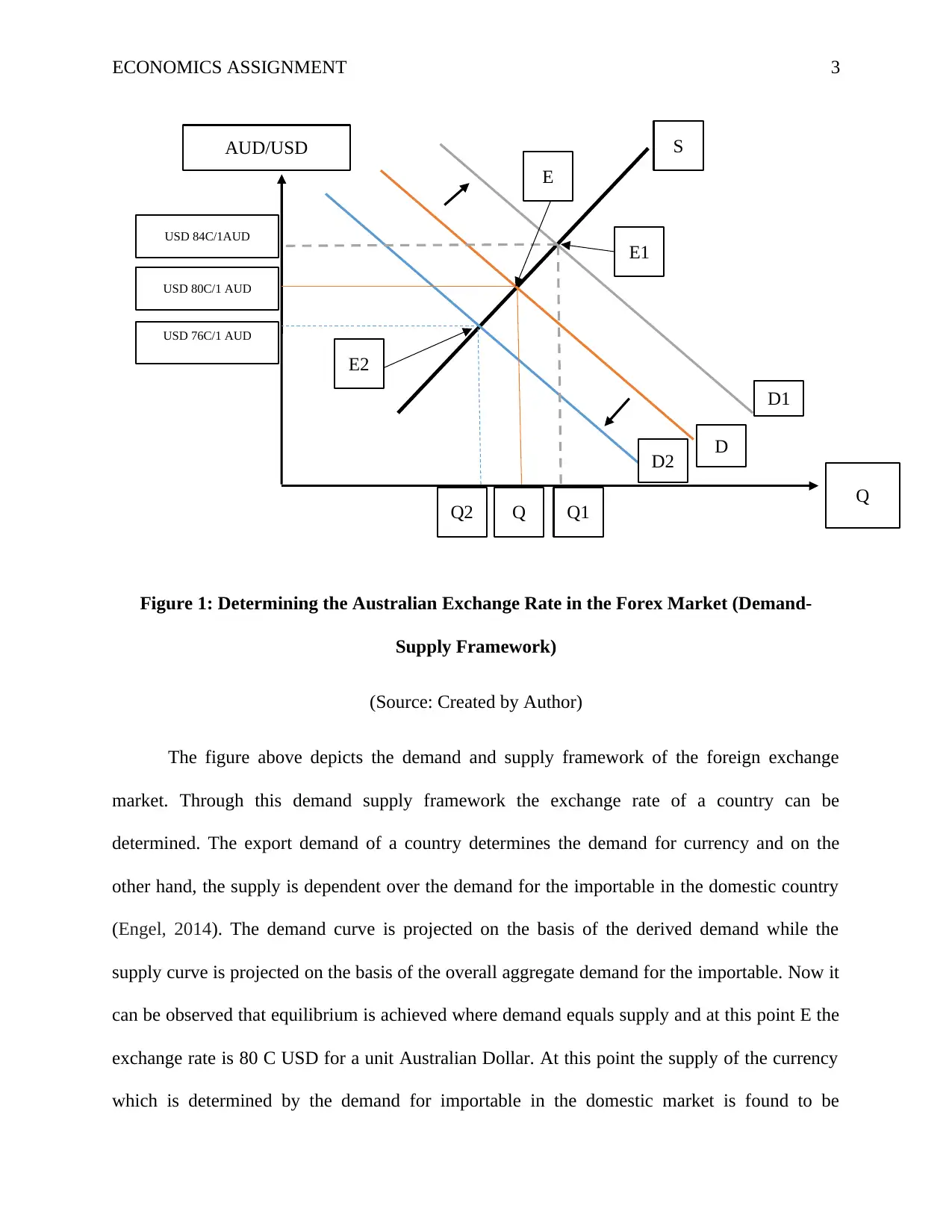
AUD/USD
Q
USD 84C/1AUD
USD 76C/1 AUD
USD 80C/1 AUD
Q2 Q Q1
E
E1
S
D2 D
D1
E2
ECONOMICS ASSIGNMENT 3
Figure 1: Determining the Australian Exchange Rate in the Forex Market (Demand-
Supply Framework)
(Source: Created by Author)
The figure above depicts the demand and supply framework of the foreign exchange
market. Through this demand supply framework the exchange rate of a country can be
determined. The export demand of a country determines the demand for currency and on the
other hand, the supply is dependent over the demand for the importable in the domestic country
(Engel, 2014). The demand curve is projected on the basis of the derived demand while the
supply curve is projected on the basis of the overall aggregate demand for the importable. Now it
can be observed that equilibrium is achieved where demand equals supply and at this point E the
exchange rate is 80 C USD for a unit Australian Dollar. At this point the supply of the currency
which is determined by the demand for importable in the domestic market is found to be
Q
USD 84C/1AUD
USD 76C/1 AUD
USD 80C/1 AUD
Q2 Q Q1
E
E1
S
D2 D
D1
E2
ECONOMICS ASSIGNMENT 3
Figure 1: Determining the Australian Exchange Rate in the Forex Market (Demand-
Supply Framework)
(Source: Created by Author)
The figure above depicts the demand and supply framework of the foreign exchange
market. Through this demand supply framework the exchange rate of a country can be
determined. The export demand of a country determines the demand for currency and on the
other hand, the supply is dependent over the demand for the importable in the domestic country
(Engel, 2014). The demand curve is projected on the basis of the derived demand while the
supply curve is projected on the basis of the overall aggregate demand for the importable. Now it
can be observed that equilibrium is achieved where demand equals supply and at this point E the
exchange rate is 80 C USD for a unit Australian Dollar. At this point the supply of the currency
which is determined by the demand for importable in the domestic market is found to be
Paraphrase This Document
Need a fresh take? Get an instant paraphrase of this document with our AI Paraphraser

ECONOMICS ASSIGNMENT 4
represented by point Q. Now let us suppose that there is an increase in the demand for AUD and
it moves from Q to Q1, the demand curve shifts upwards to the right to D1 as a result there is a
increase in the rate of exchange for every unit of AUD in comparison to the initial equilibrium
condition. On the other hand, when there is a fall in the quantity demanded the demand curve
shift downwards to the left and a result of which the exchange rate further depreciates for each
unit of the AUD.
As per the analysis it can be stated that exchange rate in a floating exchange rate regime
is strictly determined by the interaction of demand and supply of currency and there are various
factors which contributes to the fluctuations in this demand and supply factors (Cenedese et al.,
2015). In brief these factors can be summarized as follows,
Rate of inflation: An increase in the rate of inflation will lead to a depreciation in the
AUD which will in turn shift the demand curve towards the left.
Growth rate: If the demand for the export of goods and services produced in Australia
increase due to an increased growth rate the exchange rate will be appreciated and shift
the demand curve to the right (McCombie and Thirlwall, 2016).
o Plans implemented by government: Implementing a policy that supports
promotion of exports and substitution of exports will help in appreciating the
exchange rate of the country.
Answer to Question b:
The exchange rate can be divided into two categories nominal exchange rate and real
exchange rate. The nominal exchange rate can be defined as the units or amount of domestic
currency needed for purchasing a single unit of the foreign currency (Jotikasthira et al., 2015). A
represented by point Q. Now let us suppose that there is an increase in the demand for AUD and
it moves from Q to Q1, the demand curve shifts upwards to the right to D1 as a result there is a
increase in the rate of exchange for every unit of AUD in comparison to the initial equilibrium
condition. On the other hand, when there is a fall in the quantity demanded the demand curve
shift downwards to the left and a result of which the exchange rate further depreciates for each
unit of the AUD.
As per the analysis it can be stated that exchange rate in a floating exchange rate regime
is strictly determined by the interaction of demand and supply of currency and there are various
factors which contributes to the fluctuations in this demand and supply factors (Cenedese et al.,
2015). In brief these factors can be summarized as follows,
Rate of inflation: An increase in the rate of inflation will lead to a depreciation in the
AUD which will in turn shift the demand curve towards the left.
Growth rate: If the demand for the export of goods and services produced in Australia
increase due to an increased growth rate the exchange rate will be appreciated and shift
the demand curve to the right (McCombie and Thirlwall, 2016).
o Plans implemented by government: Implementing a policy that supports
promotion of exports and substitution of exports will help in appreciating the
exchange rate of the country.
Answer to Question b:
The exchange rate can be divided into two categories nominal exchange rate and real
exchange rate. The nominal exchange rate can be defined as the units or amount of domestic
currency needed for purchasing a single unit of the foreign currency (Jotikasthira et al., 2015). A
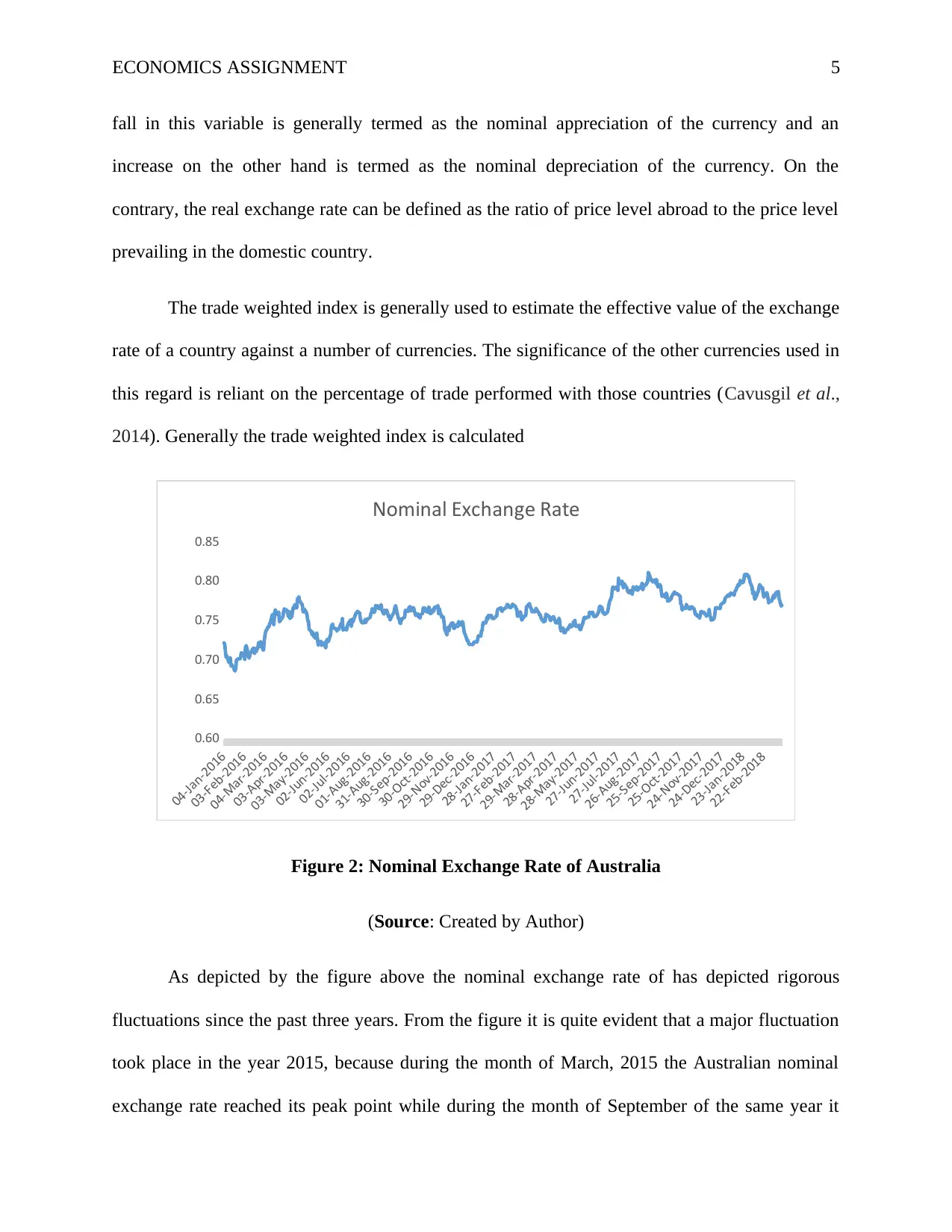
ECONOMICS ASSIGNMENT 5
fall in this variable is generally termed as the nominal appreciation of the currency and an
increase on the other hand is termed as the nominal depreciation of the currency. On the
contrary, the real exchange rate can be defined as the ratio of price level abroad to the price level
prevailing in the domestic country.
The trade weighted index is generally used to estimate the effective value of the exchange
rate of a country against a number of currencies. The significance of the other currencies used in
this regard is reliant on the percentage of trade performed with those countries (Cavusgil et al.,
2014). Generally the trade weighted index is calculated
04-Jan-2016
03-Feb-2016
04-Mar-2016
03-Apr-2016
03-May-2016
02-Jun-2016
02-Jul-2016
01-Aug-2016
31-Aug-2016
30-Sep-2016
30-Oct-2016
29-Nov-2016
29-Dec-2016
28-Jan-2017
27-Feb-2017
29-Mar-2017
28-Apr-2017
28-May-2017
27-Jun-2017
27-Jul-2017
26-Aug-2017
25-Sep-2017
25-Oct-2017
24-Nov-2017
24-Dec-2017
23-Jan-2018
22-Feb-2018
0.60
0.65
0.70
0.75
0.80
0.85
Nominal Exchange Rate
Figure 2: Nominal Exchange Rate of Australia
(Source: Created by Author)
As depicted by the figure above the nominal exchange rate of has depicted rigorous
fluctuations since the past three years. From the figure it is quite evident that a major fluctuation
took place in the year 2015, because during the month of March, 2015 the Australian nominal
exchange rate reached its peak point while during the month of September of the same year it
fall in this variable is generally termed as the nominal appreciation of the currency and an
increase on the other hand is termed as the nominal depreciation of the currency. On the
contrary, the real exchange rate can be defined as the ratio of price level abroad to the price level
prevailing in the domestic country.
The trade weighted index is generally used to estimate the effective value of the exchange
rate of a country against a number of currencies. The significance of the other currencies used in
this regard is reliant on the percentage of trade performed with those countries (Cavusgil et al.,
2014). Generally the trade weighted index is calculated
04-Jan-2016
03-Feb-2016
04-Mar-2016
03-Apr-2016
03-May-2016
02-Jun-2016
02-Jul-2016
01-Aug-2016
31-Aug-2016
30-Sep-2016
30-Oct-2016
29-Nov-2016
29-Dec-2016
28-Jan-2017
27-Feb-2017
29-Mar-2017
28-Apr-2017
28-May-2017
27-Jun-2017
27-Jul-2017
26-Aug-2017
25-Sep-2017
25-Oct-2017
24-Nov-2017
24-Dec-2017
23-Jan-2018
22-Feb-2018
0.60
0.65
0.70
0.75
0.80
0.85
Nominal Exchange Rate
Figure 2: Nominal Exchange Rate of Australia
(Source: Created by Author)
As depicted by the figure above the nominal exchange rate of has depicted rigorous
fluctuations since the past three years. From the figure it is quite evident that a major fluctuation
took place in the year 2015, because during the month of March, 2015 the Australian nominal
exchange rate reached its peak point while during the month of September of the same year it
⊘ This is a preview!⊘
Do you want full access?
Subscribe today to unlock all pages.

Trusted by 1+ million students worldwide
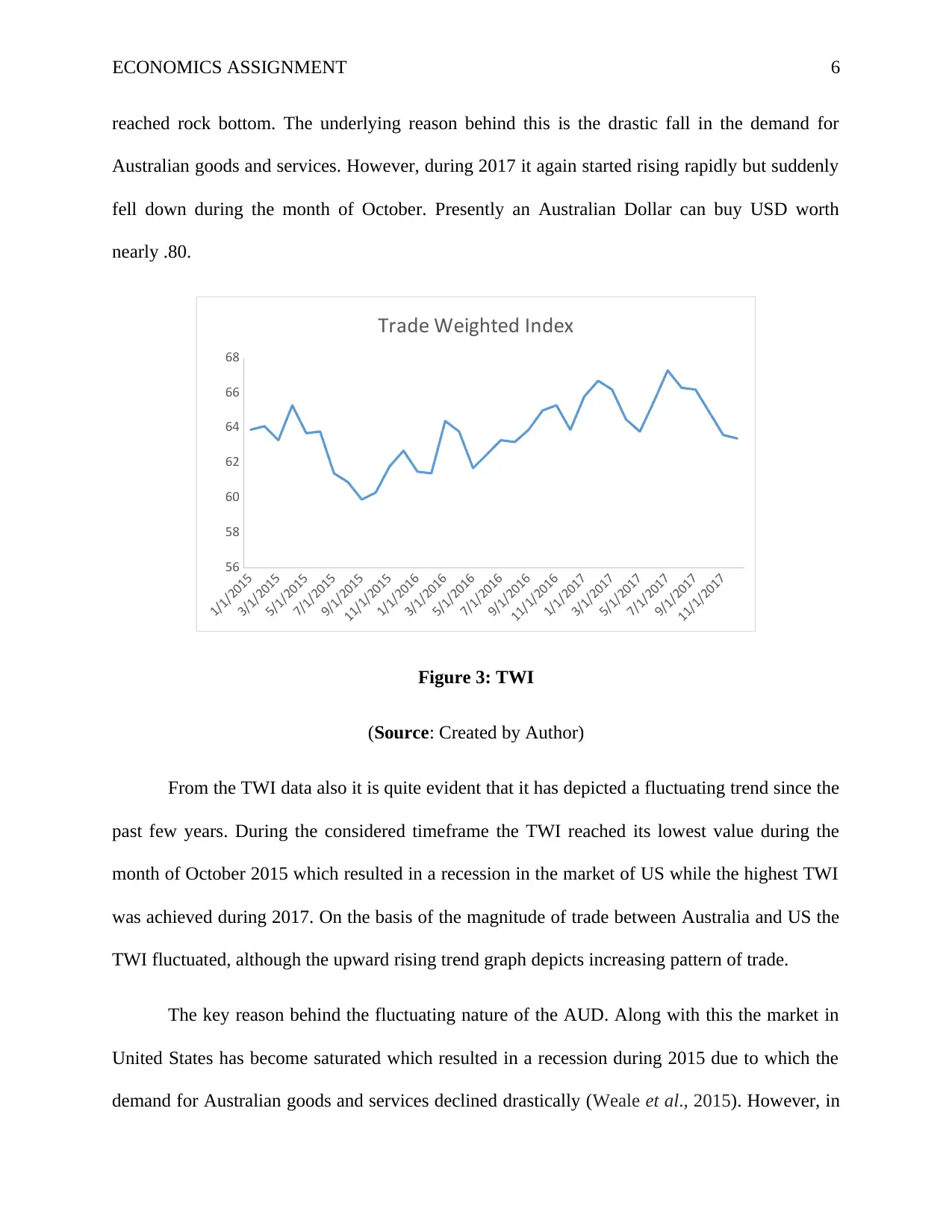
ECONOMICS ASSIGNMENT 6
reached rock bottom. The underlying reason behind this is the drastic fall in the demand for
Australian goods and services. However, during 2017 it again started rising rapidly but suddenly
fell down during the month of October. Presently an Australian Dollar can buy USD worth
nearly .80.
1/1/2015
3/1/2015
5/1/2015
7/1/2015
9/1/2015
11/1/2015
1/1/2016
3/1/2016
5/1/2016
7/1/2016
9/1/2016
11/1/2016
1/1/2017
3/1/2017
5/1/2017
7/1/2017
9/1/2017
11/1/2017
56
58
60
62
64
66
68
Trade Weighted Index
Figure 3: TWI
(Source: Created by Author)
From the TWI data also it is quite evident that it has depicted a fluctuating trend since the
past few years. During the considered timeframe the TWI reached its lowest value during the
month of October 2015 which resulted in a recession in the market of US while the highest TWI
was achieved during 2017. On the basis of the magnitude of trade between Australia and US the
TWI fluctuated, although the upward rising trend graph depicts increasing pattern of trade.
The key reason behind the fluctuating nature of the AUD. Along with this the market in
United States has become saturated which resulted in a recession during 2015 due to which the
demand for Australian goods and services declined drastically (Weale et al., 2015). However, in
reached rock bottom. The underlying reason behind this is the drastic fall in the demand for
Australian goods and services. However, during 2017 it again started rising rapidly but suddenly
fell down during the month of October. Presently an Australian Dollar can buy USD worth
nearly .80.
1/1/2015
3/1/2015
5/1/2015
7/1/2015
9/1/2015
11/1/2015
1/1/2016
3/1/2016
5/1/2016
7/1/2016
9/1/2016
11/1/2016
1/1/2017
3/1/2017
5/1/2017
7/1/2017
9/1/2017
11/1/2017
56
58
60
62
64
66
68
Trade Weighted Index
Figure 3: TWI
(Source: Created by Author)
From the TWI data also it is quite evident that it has depicted a fluctuating trend since the
past few years. During the considered timeframe the TWI reached its lowest value during the
month of October 2015 which resulted in a recession in the market of US while the highest TWI
was achieved during 2017. On the basis of the magnitude of trade between Australia and US the
TWI fluctuated, although the upward rising trend graph depicts increasing pattern of trade.
The key reason behind the fluctuating nature of the AUD. Along with this the market in
United States has become saturated which resulted in a recession during 2015 due to which the
demand for Australian goods and services declined drastically (Weale et al., 2015). However, in
Paraphrase This Document
Need a fresh take? Get an instant paraphrase of this document with our AI Paraphraser
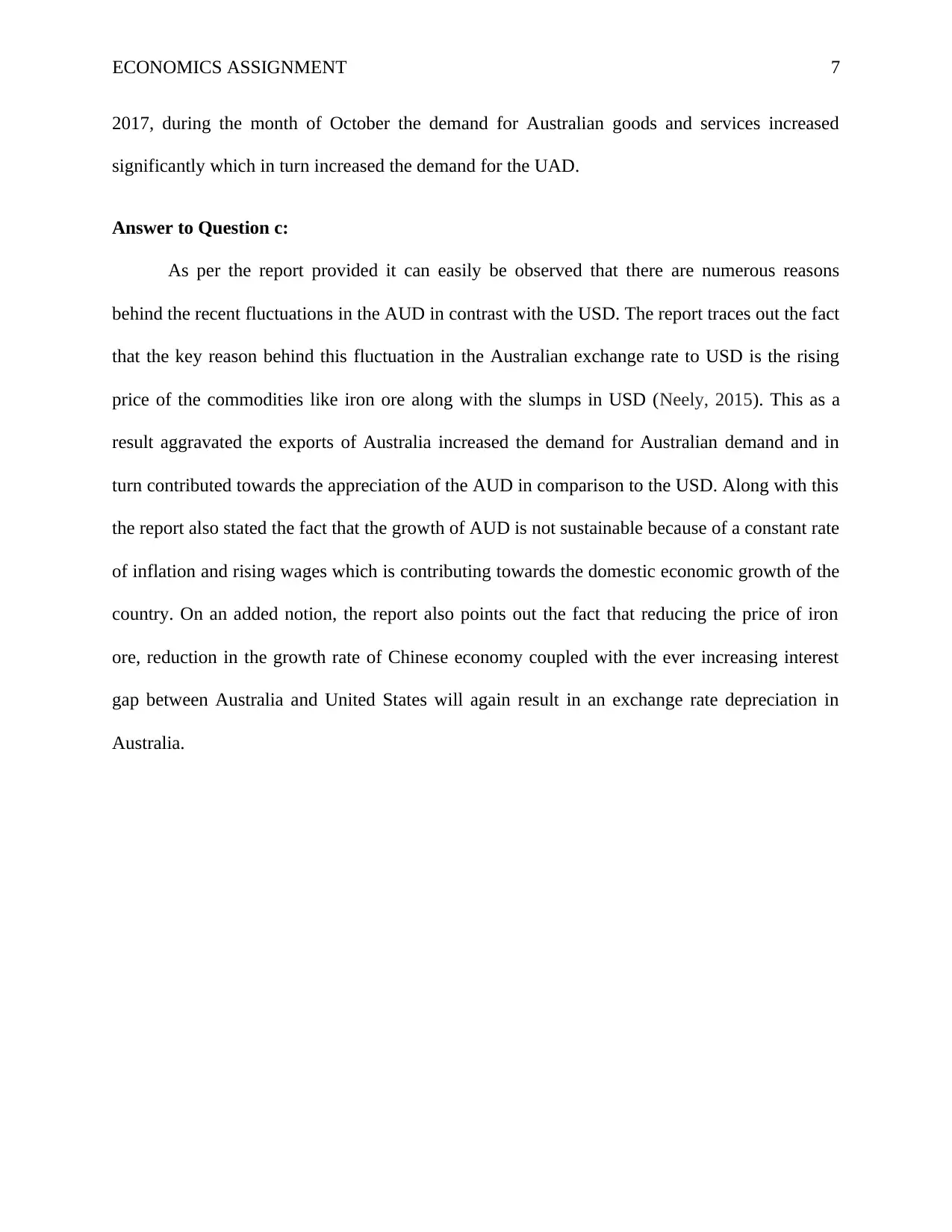
ECONOMICS ASSIGNMENT 7
2017, during the month of October the demand for Australian goods and services increased
significantly which in turn increased the demand for the UAD.
Answer to Question c:
As per the report provided it can easily be observed that there are numerous reasons
behind the recent fluctuations in the AUD in contrast with the USD. The report traces out the fact
that the key reason behind this fluctuation in the Australian exchange rate to USD is the rising
price of the commodities like iron ore along with the slumps in USD (Neely, 2015). This as a
result aggravated the exports of Australia increased the demand for Australian demand and in
turn contributed towards the appreciation of the AUD in comparison to the USD. Along with this
the report also stated the fact that the growth of AUD is not sustainable because of a constant rate
of inflation and rising wages which is contributing towards the domestic economic growth of the
country. On an added notion, the report also points out the fact that reducing the price of iron
ore, reduction in the growth rate of Chinese economy coupled with the ever increasing interest
gap between Australia and United States will again result in an exchange rate depreciation in
Australia.
2017, during the month of October the demand for Australian goods and services increased
significantly which in turn increased the demand for the UAD.
Answer to Question c:
As per the report provided it can easily be observed that there are numerous reasons
behind the recent fluctuations in the AUD in contrast with the USD. The report traces out the fact
that the key reason behind this fluctuation in the Australian exchange rate to USD is the rising
price of the commodities like iron ore along with the slumps in USD (Neely, 2015). This as a
result aggravated the exports of Australia increased the demand for Australian demand and in
turn contributed towards the appreciation of the AUD in comparison to the USD. Along with this
the report also stated the fact that the growth of AUD is not sustainable because of a constant rate
of inflation and rising wages which is contributing towards the domestic economic growth of the
country. On an added notion, the report also points out the fact that reducing the price of iron
ore, reduction in the growth rate of Chinese economy coupled with the ever increasing interest
gap between Australia and United States will again result in an exchange rate depreciation in
Australia.
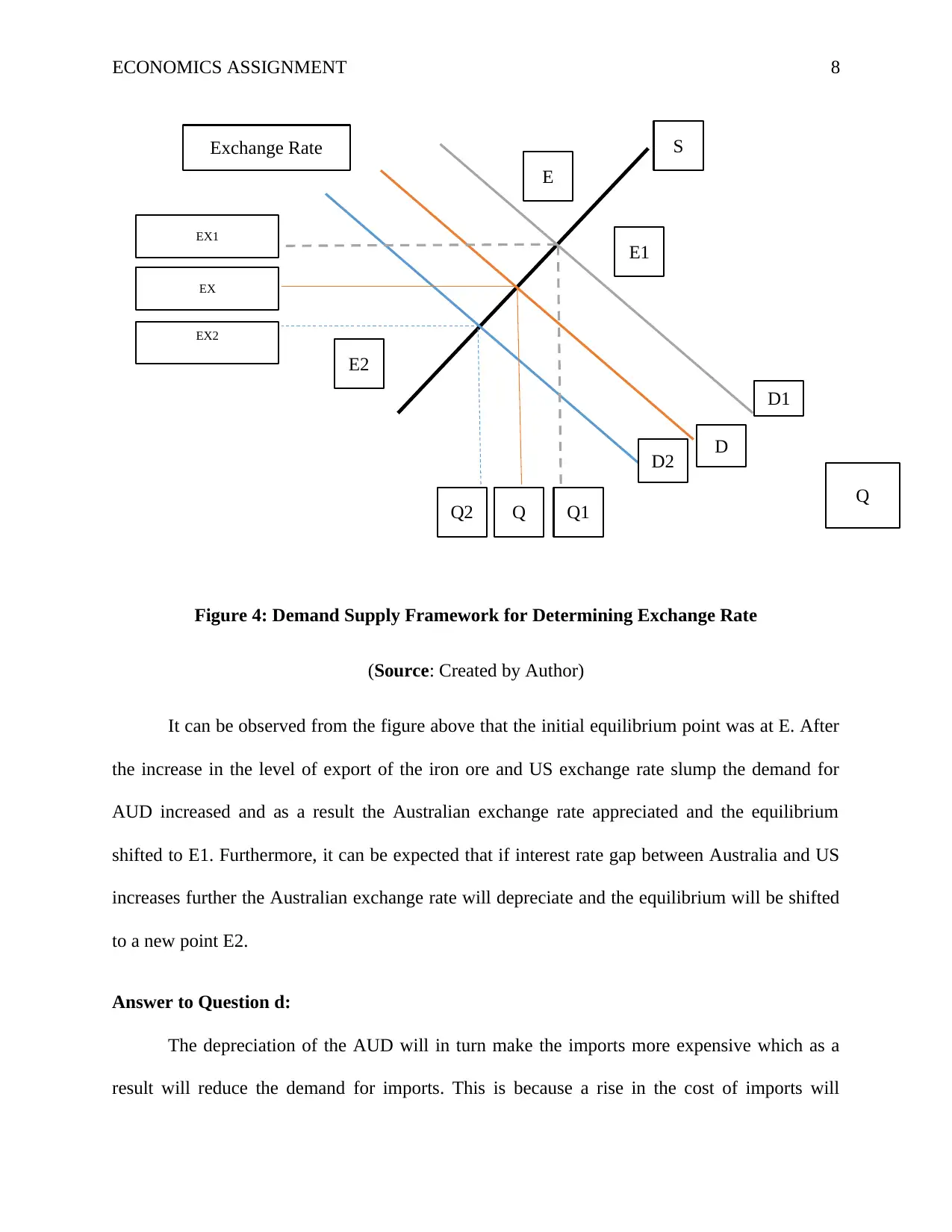
Exchange Rate
Q
EX1
EX2
EX
Q2 Q Q1
E
E1
S
D2 D
D1
E2
ECONOMICS ASSIGNMENT 8
Figure 4: Demand Supply Framework for Determining Exchange Rate
(Source: Created by Author)
It can be observed from the figure above that the initial equilibrium point was at E. After
the increase in the level of export of the iron ore and US exchange rate slump the demand for
AUD increased and as a result the Australian exchange rate appreciated and the equilibrium
shifted to E1. Furthermore, it can be expected that if interest rate gap between Australia and US
increases further the Australian exchange rate will depreciate and the equilibrium will be shifted
to a new point E2.
Answer to Question d:
The depreciation of the AUD will in turn make the imports more expensive which as a
result will reduce the demand for imports. This is because a rise in the cost of imports will
Q
EX1
EX2
EX
Q2 Q Q1
E
E1
S
D2 D
D1
E2
ECONOMICS ASSIGNMENT 8
Figure 4: Demand Supply Framework for Determining Exchange Rate
(Source: Created by Author)
It can be observed from the figure above that the initial equilibrium point was at E. After
the increase in the level of export of the iron ore and US exchange rate slump the demand for
AUD increased and as a result the Australian exchange rate appreciated and the equilibrium
shifted to E1. Furthermore, it can be expected that if interest rate gap between Australia and US
increases further the Australian exchange rate will depreciate and the equilibrium will be shifted
to a new point E2.
Answer to Question d:
The depreciation of the AUD will in turn make the imports more expensive which as a
result will reduce the demand for imports. This is because a rise in the cost of imports will
⊘ This is a preview!⊘
Do you want full access?
Subscribe today to unlock all pages.

Trusted by 1+ million students worldwide
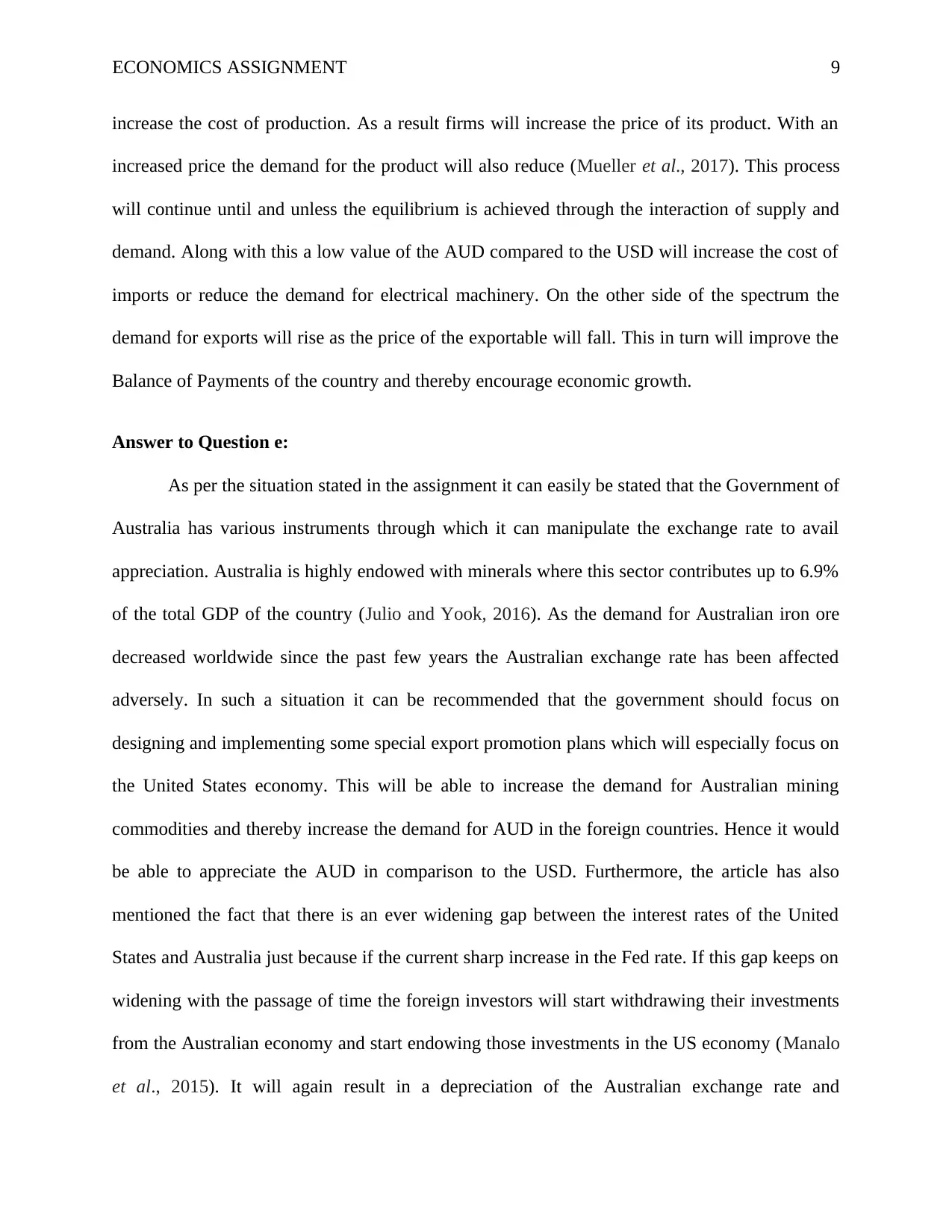
ECONOMICS ASSIGNMENT 9
increase the cost of production. As a result firms will increase the price of its product. With an
increased price the demand for the product will also reduce (Mueller et al., 2017). This process
will continue until and unless the equilibrium is achieved through the interaction of supply and
demand. Along with this a low value of the AUD compared to the USD will increase the cost of
imports or reduce the demand for electrical machinery. On the other side of the spectrum the
demand for exports will rise as the price of the exportable will fall. This in turn will improve the
Balance of Payments of the country and thereby encourage economic growth.
Answer to Question e:
As per the situation stated in the assignment it can easily be stated that the Government of
Australia has various instruments through which it can manipulate the exchange rate to avail
appreciation. Australia is highly endowed with minerals where this sector contributes up to 6.9%
of the total GDP of the country (Julio and Yook, 2016). As the demand for Australian iron ore
decreased worldwide since the past few years the Australian exchange rate has been affected
adversely. In such a situation it can be recommended that the government should focus on
designing and implementing some special export promotion plans which will especially focus on
the United States economy. This will be able to increase the demand for Australian mining
commodities and thereby increase the demand for AUD in the foreign countries. Hence it would
be able to appreciate the AUD in comparison to the USD. Furthermore, the article has also
mentioned the fact that there is an ever widening gap between the interest rates of the United
States and Australia just because if the current sharp increase in the Fed rate. If this gap keeps on
widening with the passage of time the foreign investors will start withdrawing their investments
from the Australian economy and start endowing those investments in the US economy (Manalo
et al., 2015). It will again result in a depreciation of the Australian exchange rate and
increase the cost of production. As a result firms will increase the price of its product. With an
increased price the demand for the product will also reduce (Mueller et al., 2017). This process
will continue until and unless the equilibrium is achieved through the interaction of supply and
demand. Along with this a low value of the AUD compared to the USD will increase the cost of
imports or reduce the demand for electrical machinery. On the other side of the spectrum the
demand for exports will rise as the price of the exportable will fall. This in turn will improve the
Balance of Payments of the country and thereby encourage economic growth.
Answer to Question e:
As per the situation stated in the assignment it can easily be stated that the Government of
Australia has various instruments through which it can manipulate the exchange rate to avail
appreciation. Australia is highly endowed with minerals where this sector contributes up to 6.9%
of the total GDP of the country (Julio and Yook, 2016). As the demand for Australian iron ore
decreased worldwide since the past few years the Australian exchange rate has been affected
adversely. In such a situation it can be recommended that the government should focus on
designing and implementing some special export promotion plans which will especially focus on
the United States economy. This will be able to increase the demand for Australian mining
commodities and thereby increase the demand for AUD in the foreign countries. Hence it would
be able to appreciate the AUD in comparison to the USD. Furthermore, the article has also
mentioned the fact that there is an ever widening gap between the interest rates of the United
States and Australia just because if the current sharp increase in the Fed rate. If this gap keeps on
widening with the passage of time the foreign investors will start withdrawing their investments
from the Australian economy and start endowing those investments in the US economy (Manalo
et al., 2015). It will again result in a depreciation of the Australian exchange rate and
Paraphrase This Document
Need a fresh take? Get an instant paraphrase of this document with our AI Paraphraser
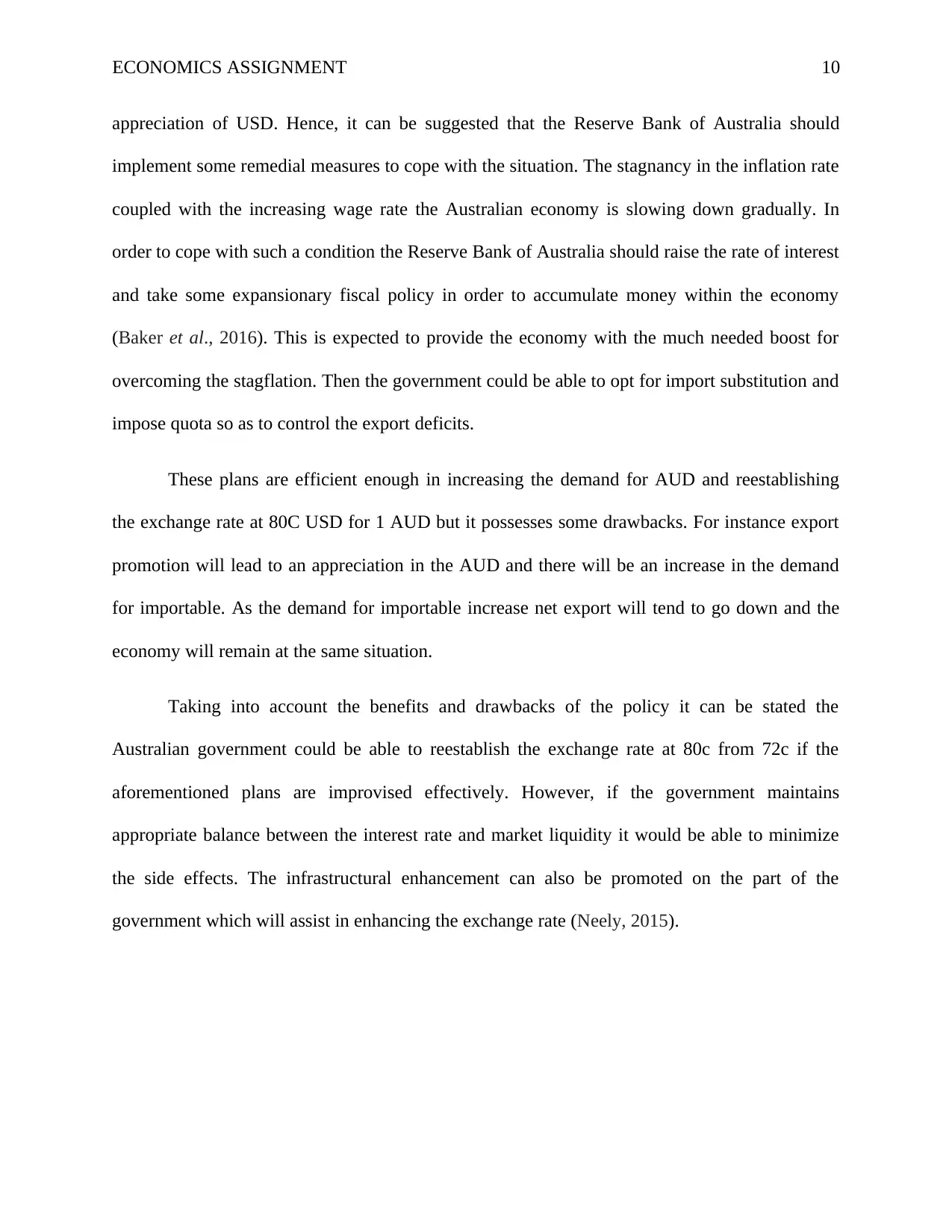
ECONOMICS ASSIGNMENT 10
appreciation of USD. Hence, it can be suggested that the Reserve Bank of Australia should
implement some remedial measures to cope with the situation. The stagnancy in the inflation rate
coupled with the increasing wage rate the Australian economy is slowing down gradually. In
order to cope with such a condition the Reserve Bank of Australia should raise the rate of interest
and take some expansionary fiscal policy in order to accumulate money within the economy
(Baker et al., 2016). This is expected to provide the economy with the much needed boost for
overcoming the stagflation. Then the government could be able to opt for import substitution and
impose quota so as to control the export deficits.
These plans are efficient enough in increasing the demand for AUD and reestablishing
the exchange rate at 80C USD for 1 AUD but it possesses some drawbacks. For instance export
promotion will lead to an appreciation in the AUD and there will be an increase in the demand
for importable. As the demand for importable increase net export will tend to go down and the
economy will remain at the same situation.
Taking into account the benefits and drawbacks of the policy it can be stated the
Australian government could be able to reestablish the exchange rate at 80c from 72c if the
aforementioned plans are improvised effectively. However, if the government maintains
appropriate balance between the interest rate and market liquidity it would be able to minimize
the side effects. The infrastructural enhancement can also be promoted on the part of the
government which will assist in enhancing the exchange rate (Neely, 2015).
appreciation of USD. Hence, it can be suggested that the Reserve Bank of Australia should
implement some remedial measures to cope with the situation. The stagnancy in the inflation rate
coupled with the increasing wage rate the Australian economy is slowing down gradually. In
order to cope with such a condition the Reserve Bank of Australia should raise the rate of interest
and take some expansionary fiscal policy in order to accumulate money within the economy
(Baker et al., 2016). This is expected to provide the economy with the much needed boost for
overcoming the stagflation. Then the government could be able to opt for import substitution and
impose quota so as to control the export deficits.
These plans are efficient enough in increasing the demand for AUD and reestablishing
the exchange rate at 80C USD for 1 AUD but it possesses some drawbacks. For instance export
promotion will lead to an appreciation in the AUD and there will be an increase in the demand
for importable. As the demand for importable increase net export will tend to go down and the
economy will remain at the same situation.
Taking into account the benefits and drawbacks of the policy it can be stated the
Australian government could be able to reestablish the exchange rate at 80c from 72c if the
aforementioned plans are improvised effectively. However, if the government maintains
appropriate balance between the interest rate and market liquidity it would be able to minimize
the side effects. The infrastructural enhancement can also be promoted on the part of the
government which will assist in enhancing the exchange rate (Neely, 2015).
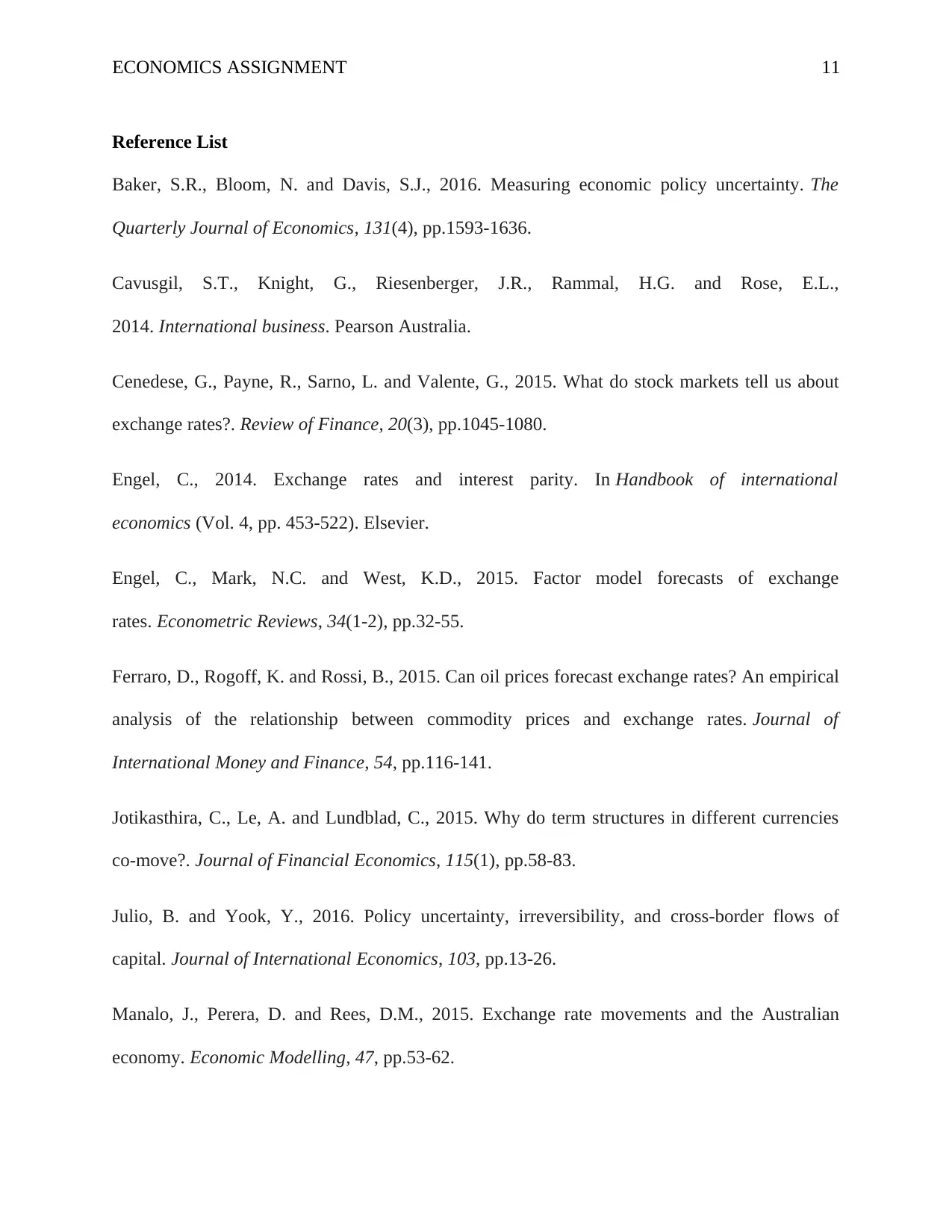
ECONOMICS ASSIGNMENT 11
Reference List
Baker, S.R., Bloom, N. and Davis, S.J., 2016. Measuring economic policy uncertainty. The
Quarterly Journal of Economics, 131(4), pp.1593-1636.
Cavusgil, S.T., Knight, G., Riesenberger, J.R., Rammal, H.G. and Rose, E.L.,
2014. International business. Pearson Australia.
Cenedese, G., Payne, R., Sarno, L. and Valente, G., 2015. What do stock markets tell us about
exchange rates?. Review of Finance, 20(3), pp.1045-1080.
Engel, C., 2014. Exchange rates and interest parity. In Handbook of international
economics (Vol. 4, pp. 453-522). Elsevier.
Engel, C., Mark, N.C. and West, K.D., 2015. Factor model forecasts of exchange
rates. Econometric Reviews, 34(1-2), pp.32-55.
Ferraro, D., Rogoff, K. and Rossi, B., 2015. Can oil prices forecast exchange rates? An empirical
analysis of the relationship between commodity prices and exchange rates. Journal of
International Money and Finance, 54, pp.116-141.
Jotikasthira, C., Le, A. and Lundblad, C., 2015. Why do term structures in different currencies
co-move?. Journal of Financial Economics, 115(1), pp.58-83.
Julio, B. and Yook, Y., 2016. Policy uncertainty, irreversibility, and cross-border flows of
capital. Journal of International Economics, 103, pp.13-26.
Manalo, J., Perera, D. and Rees, D.M., 2015. Exchange rate movements and the Australian
economy. Economic Modelling, 47, pp.53-62.
Reference List
Baker, S.R., Bloom, N. and Davis, S.J., 2016. Measuring economic policy uncertainty. The
Quarterly Journal of Economics, 131(4), pp.1593-1636.
Cavusgil, S.T., Knight, G., Riesenberger, J.R., Rammal, H.G. and Rose, E.L.,
2014. International business. Pearson Australia.
Cenedese, G., Payne, R., Sarno, L. and Valente, G., 2015. What do stock markets tell us about
exchange rates?. Review of Finance, 20(3), pp.1045-1080.
Engel, C., 2014. Exchange rates and interest parity. In Handbook of international
economics (Vol. 4, pp. 453-522). Elsevier.
Engel, C., Mark, N.C. and West, K.D., 2015. Factor model forecasts of exchange
rates. Econometric Reviews, 34(1-2), pp.32-55.
Ferraro, D., Rogoff, K. and Rossi, B., 2015. Can oil prices forecast exchange rates? An empirical
analysis of the relationship between commodity prices and exchange rates. Journal of
International Money and Finance, 54, pp.116-141.
Jotikasthira, C., Le, A. and Lundblad, C., 2015. Why do term structures in different currencies
co-move?. Journal of Financial Economics, 115(1), pp.58-83.
Julio, B. and Yook, Y., 2016. Policy uncertainty, irreversibility, and cross-border flows of
capital. Journal of International Economics, 103, pp.13-26.
Manalo, J., Perera, D. and Rees, D.M., 2015. Exchange rate movements and the Australian
economy. Economic Modelling, 47, pp.53-62.
⊘ This is a preview!⊘
Do you want full access?
Subscribe today to unlock all pages.

Trusted by 1+ million students worldwide
1 out of 13
Related Documents
Your All-in-One AI-Powered Toolkit for Academic Success.
+13062052269
info@desklib.com
Available 24*7 on WhatsApp / Email
![[object Object]](/_next/static/media/star-bottom.7253800d.svg)
Unlock your academic potential
Copyright © 2020–2025 A2Z Services. All Rights Reserved. Developed and managed by ZUCOL.





